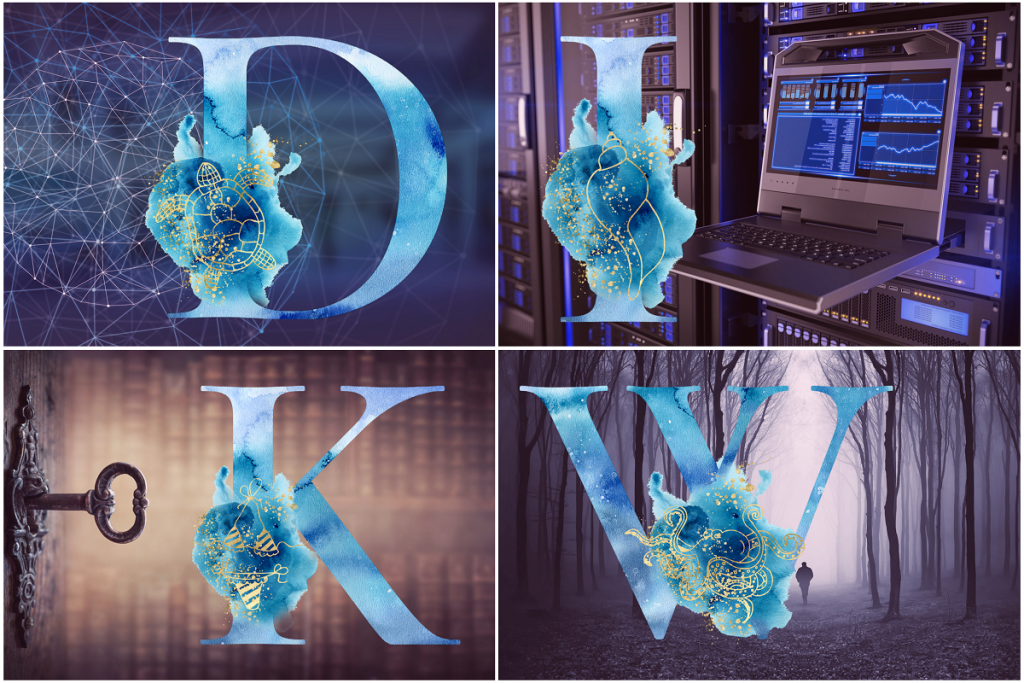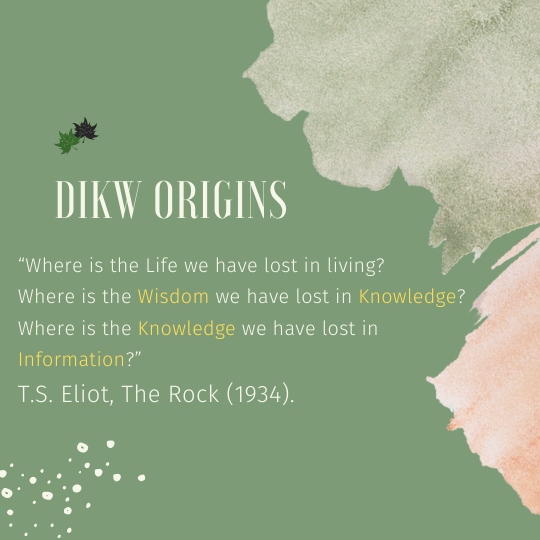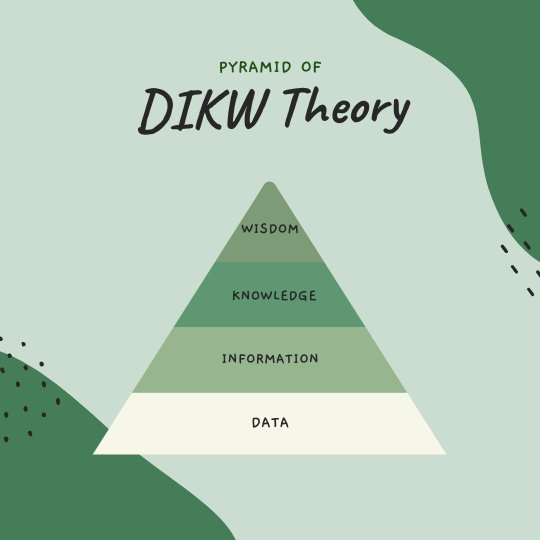by June Kaminski, RN MSN PhD(c)
Editor in Chief
CJNI was initiated by June Kaminski in 2006 when she was President-Elect of CNIA. She is currently Faculty and Curriculum Coordinator of a BSN Advanced Entry nursing program at Kwantlen Polytechnic University; Communications Officer, Webmaster, and former President of the Canadian Association of Nurses for the Environment and Editor in Chief of the Online Journal of Nursing Informatics. In 2012, June was honoured to receive the CASN and Canada Health Infoway’s inaugural Nursing Faculty E-Health Award 2012 in Ottawa Canada. She also won the Distinguished Teaching Award from Kwantlen Polytechnic University in 2016. She offers the Nursing Informatics Learning Center with accredited CEU informatics courses.
Citation: Kaminski, J. (2021). Theory applied to informatics: DIKW Theory Editorial. Canadian Journal of Nursing Informatics, 16(3-4). https://cjni.net/journal/?p=9374
EDITORIAL

Theory is an important aspect of nursing informatics – one that is often neglected due to time and context. The DIKW theory, short for Data – Information – Knowledge – Wisdom has evolved over the years across a variety of disciplines and is one of the most embraced in nursing informatics and “considered by some as the canon of information science and knowledge management” (Gackowski, 2012, p. 93) and one of the most widely recognized theories in informatics (McDowell, 2021).
Charlene Ronquillo, Leanne Currie and Paddy Rodney (2016) described the DIKW as being both a middle-range theory and a grand theory. “DIKW falls under the criteria of a grand theory, as it outlines a theoretical framework of abstract concepts with specific relationships that attempt to explain a specific phenomenon (the movement from data to wisdom), with limited capacity for empirical testing. However, DIKW also has features of middle-range theory such as having implicit philosophical assumptions, being sufficiently general to cross multiple clinical populations, and providing specifics to guide research and practice. DIKW explicitly outlines each step of the theoretical framework and provides clear direction as to how data can be processed and transformed from discrete entities to components of a complex knowledge base and further, describing how arriving at wisdom ultimately guides clinical practice and decision making” (p. E.15).
Evolution of the Theory
Several authors have outlined the evolution of the DIKW theory, some with alternate branches and acknowledgements. Most credit the first mention of this paradigm to none other than well-known author, T. S. Eliot who referred to at least part of it in his play, The Rock in 1934. The particular stanza that is credited goes like this (Figure 1):

In 2008, Nikhil Sharma credited the next step in defining this theory to Harland Cleveland (1982) who wrote about information, knowledge and wisdom in his Futurist article. Michael Zeleny (1987) is credited with the first formal treatise on the dimensions as he strove to describe how to achieve integrated knowledge management “by equating Data, Information, Knowledge and Wisdom to various knowledge forms: “know nothing”, “know what”, “know how” and “know why” respectively” (Sharma, 2008, p. 2). Zeleny (1987) also proposed a fifth tier, enlightenment, which became the apex of the pyramid above wisdom. Russell Ackoff (1989) is often credited as the originator of the DIKW when he presented a 1988 Presidential Address to the International Society for General Systems Research (ISGSR). Ackoff described the four dimensions with an added fifth dimension of “understanding” as a linking concept between knowledge and wisdom, “thus Ackoff’s hierarchy is Data, Information, Knowledge, Understanding, and Wisdom” (Sharma, 2008, p. 2).
Bellinger et al., (2004) theorized that Understanding was not a separate tier of the hierarchy, but rather, a connecting concept that wove the other four together. Thus, data led to information by understanding relations; information led to knowledge by understanding patterns and knowledge could lead to wisdom by understanding principles. “Understanding is therefore identified as the transformational relationship among data, information, knowledge, and wisdom to create an outcome at a higher level” (Faucher et al., 2008, p. 7) through the process of connectedness. “Many informed people know what to do, quite a few knowledgeable experts know how to do it, but only a few wise persons know and can fully explicate why it should be done” (Aven, 2013, p. 31).
This theory is often presented in the form of a pyramid or hierarchy (Figure 2) with data at the bottom and wisdom at the top, however, most point out that the steps are not linear but interwoven (Frické, 2009, 2019). The pyramid shape suggests the simple to complex properties of the theory (Decker et al., 2018, p. 300). “Information consists of data, but data is not necessarily information. Also, wisdom is knowledge, which in turn is information, which in turn is data, but, for example, knowledge is not necessarily wisdom. So, wisdom is a subset of knowledge, which is a subset of information, which is a subset of data. The terms Data, Information, Knowledge, and Wisdom are sometimes presented in a form that suggests a scale. However, in no sense do these four terms define some sort of linear equal-interval scale” (Alivelu et al, 2015, p. 3). On the other hand, Neumann (2020) mused that “each step up the pyramid answers questions about and adds value to the initial data” reinforcing the hierarchal structure of this theory (p.1).

Bierly, et al. (2000) described the DIKW theory in the context of educational theory, linking each of the four dimensions to other educational theories, including Benjamin Bloom’s (1956) Taxonomy of Educational Objectives. Data was described as raw facts that are accumulated in the learner through memorization and accumulation of facts (first level of learning). Information is data that is processed by a learner to become meaningful and useful, thus gives form and functionality to data through comprehension (second level of learning). Knowledge is distinguished as “knowing how” or tacit knowledge and “knowing why” or explicit knowledge coupled with the cognitive processes of analysis and synthesis (Bloom’s fourth and fifth level of learning) which includes “an understanding of information and associated patterns” (Bierly et al., 2000, p. 601). Finally, wisdom is equated with Bloom’s sixth level of Evaluation, defined as “the ability to best use knowledge for establishing and achieving desired goals and learning about wisdom as the process of discerning judgements and action based on knowledge” (Bierly et al., 2000, p. 601).
Jonathan Hey (2004) took a metaphorical approach to analyze the DIKW theory, affording an interesting view on how we talk about the firs three tiers – data, information, and knowledge. Particularly, in this day and age of copious amounts of data and information, these metaphors make us think. For instance, data is often alluded to as “data streams” or we are “drowning in data.” People often refer to the “volume of information” available, or that information “pours across the internet “, “information flows across channels” or we are “bombarded with information.” Knowledge is often viewed as tacit or “personal and context-specific” or explicit. “It is explicit knowledge that most current knowledge management practices try to, and indeed are able to, capture, acquire, create, leverage, retain, codify, store, transfer and share” (p. 10). Metaphorically, knowledge can be “sticky” or “leaky” or “crystallized”. Hey concluded that “this analysis seems to add weight to the visual metaphor provided by the ‘Knowledge pyramid’ where large amounts of data are distilled to a smaller quantity of information, which is, in turn, aggregated to create yet more distilled, though more widely applicable, knowledge” (2004, p. 15).
Colonal Harry Tunnell (2014) examined the fit between the DIKW theory and network-centric war commanding and surmised that the “DIKW hierarchy is a knowledge management structure that helps people make data become meaningful for decision making” (p. 45). Despite its common use, the DIKW theory has had both good and bad reviews (Ronquillo et al., 2016; Frické, 2009, 2019). Sasa Baškarada and Andy Koronios (2013) defended the utility of the DIKW despite many critics: “Some have gone even further, arguing that the hierarchy is based on flawed assumptions and that it should be abandoned altogether (Frické, 2009). However, given that most information systems literature relies on these concepts, abandoning the hierarchy does not seem feasible. As a result, developing clear, consistent, and unambiguous definitions of the terms, their relationships, and their quality dimensions is imperative” (p. 8).
To understand the theory, the four dimensions: data, information, knowledge, and wisdom should be examined.
Data
Data are considered the simplest and most basic element of the theory, and come in many forms: numbers, letters, images, sentences, and so on. Electronic health records are rich in client data. “Indeed, the appeal of DIKW relates to its fit with the way computers process information. In the context of computerized systems, it is logical and necessary to view data as value-free facts that are observable and measurable in order for computerized information systems to function. Furthermore, the propositions that data are basic, discrete, “building blocks,” processed data and addition of context creates information, and synthesizing information and identifying patterns and relationships create knowledge are features that can be programmed into computerized clinical information systems” (Ronquillo, et al., 2016, p. E.11).
With the advent of big data, the whole concept of data has skyrocketed far beyond was conceived as data back in the 1980s when the theory was first emerging. “Big data also captures what we have conventionally not regarded as data. To the conventional varieties – facts, signals, symbols – big data captures behaviour, emotions, actions, and attitudes as raw data. Consumer behaviour is captured as data routinely by online shops. Mood and emotions in images, videos, audio and other digital media can be recognised and captured as data. Whereas laborious surveys gathered data on attitudes, now it is instantly acquired simply by clicks. All of our interaction on such platforms as Facebook, Instagram, Twitter, our language and expressions, our likes and shares, are turned into data. Indeed, almost every aspect of what makes an individual truly individual, a community, the fundamental properties that define their identities are quantified and seized by big data. In short, big data incorporates the essence of individuals, groups and communities” (Sardar, 2020, p. 5).
Information
In this theory, information emerges from data. “Information may be thought of as “data plus meaning.” It can be derived by processing data. Information represents the facts and ideas that are available to be known within a certain context. When data are put into a context and combinedwithin a structure, information emerges” (Matney et al., 2011, p. 8). Information has become so common and so profuse that our current era has been dubbed “the information age” where “we over-invest in information and under-invest in knowledge and wisdom” (Mayer, 2005, p. 69).
Tunnel described information as “data that have been transformed to have meaning for human beings by being organized with specific relationships between the data. Information adds value to a person’s understanding about something. People use an IS to perform this transformation” (2014, p. 45).
Knowledge
The third dimension of the DIKW is knowledge, a concept that has become both elusive yet used continuously. “Knowledge has six key characteristics: it is subjective as well as objective, it is context sensitive, it has both collective and personal components, it has a tacit and explicit nature, it has a limited shelf life in terms of usability and infinite shelf life as a piece of information, and it is functional when you apply it and informational when you acquire it” (Hoppe, 2011, p. 155). Knowledge is a process of making meaning of information, “however, without the dimensions of context, culture, tacitness, and time, this knowledge would be little more than information” (p. 155).
“Explicit knowledge is what knowledge management systems (such as computer decision support systems) seek to capture, codify, store, transfer, and share. Like the transformation of data to information, the transformation of information to knowledge in nursing and information systems can be conceptualized as a continuum of increasing understanding. Knowledge is derived by discovering patterns and relationships between types of information” (Matney et al., 2011, p. 8).
“Big data and gargantuan information have radically transformed modes of the production of knowledge as well as the nature of knowledge itself. We describe big data and gargantuan information driven knowledge as emergent because it is a product of interconnected, networked, evolving components: that is to say it is a complex system, that can spontaneously generate order, adaptation, feedback loops. Emergent knowledge has no borders: it is intrinsically multi-, inter- and transdisciplinary; it is simultaneously global and local; it codifies both the external and internal features of its subjects and objects. It incorporates and commodifies both the essence and being of individuals, groups and communities. It is contradictory and chaotic. And it can produce totally new manifestations of itself – which cannot be predicted, or indeed bear no relation to, its component forms” (Sardar, 2020, p. 7).
“In summary, there is general agreement that there is a relationship between knowledge and wisdom, but that relationship is complex. Being knowledgeable is not the same thing as being wise. A knowledgeable person has a complex explicit and tacit knowledge base on which to draw and has the capacity to understand complex situations. A wise person has, in addition the capacity to demonstrate sound judgement, which takes into account social, ethical, relationship organisational and environmental issues. When they exercise wisdom, they use this capacity to promote decision making and action” (Rowley, 2006b, p. 258).
Wisdom
Wisdom is perhaps the most elusive dimension in this theory and has been defined in a myriad of ways throughout human history (Kaufman, 2006; Kupetz, 2013; Miscevic, 2012; Murray, 2010; Ryan, 2012). In the context of this theory, the following definition seems to be one of the most poignant and applicable: “Wisdom or sapience is the ability to think and act using knowledge, experience, understanding, common sense, and insight. Wisdom has been regarded as one of four cardinal virtues; and as a virtue, it is a habit or disposition to perform the action with the highest degree of adequacy under any given circumstance, and to avoid doing anything wrong. This implies a possession of knowledge or the seeking of knowledge application to the given circumstance. This involves an understanding of people, objects, events, situations, and the willingness as well as the ability to apply perception, judgement, and action in keeping with the understanding of what is the optimal course of action. It often requires control of one’s emotional reactions (the “passions”) so that the universal principle of reason prevails to determine one’s action” (Bohle, 2016, p. 140).
Targowski (2005) mused that wisdom is “a pragmatic unit of cognition that generates volition – a chosen way of acting and communicating. Wisdom is a process of choosing among available concept options, based on knowledge, practice, morale, or intuition, or on all of them” (p. 61).
Wisdom can also be described as “the application of intuition to accumulated knowledge applied in a visionary or anticipatory manner. People do not use an IS to create wisdom. Rather, they review knowledge discerned through data-information-knowledge transformations and apply personal intuition to create wisdom” (Tunnel, 2014, p. 45).
According to Jennifer Rowley, “The wisdom hierarchy suggests that:
- There is more data than information, than knowledge, than wisdom. Is this desirable and acceptable, or simply a statement of the status quo?
- The hierarchy with its broad base of data is safe, secure and stable.
- Wisdom is only attained after much processing of data, information and knowledge, and the process starts with data” (2007, p. 175).
“We therefore define wisdom as: the capacity to put into action the most appropriate behaviour, taking into account what is known (knowledge) and what does the most good (ethical and social considerations). This leads to a simple relationship between knowledge and wisdom. If knowledge is seen as “knowing how”, wisdom is “knowing why, what and how” to do something” (Rowley, 2006a. p. 1250). Rowley and Slack (2009) pointed out that a common theme in the literature on wisdom is its inherent link with action and judgement, and the knowledge of what is good and right (ethics) which inform strategic decision-making and making choices. Perhaps wisdom should enfold the other parts of the pyramid and knowledge should be at the central base (Figure 3).

Liew (2013, p. 59) and Efe (2016, p. 8) described six wisdom dimensions to consider:
- Reasoning ability—The unique ability to look at a problem or situation and solve it, good problem solving abilities, a logical mind.
- Sagacity—Considers advices, understands people through dealing with a variety of people, feels he/she can always learn from other people, is fair.
- Learning from ideas and environments—Attaches importance to ideas, looks at different perspectives, learns from other people’s mistakes.
- Judgment—Acts within own physical and intellectual limitations, sensible, has good judgment at all times, thinks before acting or making decisions.
- Expeditious use of information—Is experienced; seeks out information, especially details; learns and remembers and gains information from past mistakes or successes.
- Perspicacity—Offers solutions that are on the side of right and truth, able to see through things reading between the lines, the ability to understand and interpret his or her environment.
“Wisdom can thus be seen as a highly integrative, emotional and conscious, creative process” (Hoppe et al, 2011, p. 587). “The path to wisdom is then knowing when to differentiate, when to integrate, when to go after what one intends, and when to let go and `flow’ with the challenges presented” (Kaipa, 2000, p. 157). Some would say wisdom is developed over time in many nurses and is applied routinely during nursing practice. “In nursing, wisdom guides the nurse in recognizing the situation at hand based on patients’ values, nurse’s experience, and healthcare knowledge. Combining all these components, the nurse decides on a nursing intervention or action” (Topaz, 2013, p. 2).
Pauleen et al., (2017) described Social Practice Wisdom (SPW) defined as “the art of living coherently and appropriately according to the situation to produce excellence for oneself and others. Wise practitioners do this by integrating intellectual, emotional and ethical virtues in practice in a specific (cultural, social, political and economic) context, time and place. In this view, wisdom is the peak of human social excellence” (p. 403).
A collective approach to wisdom could also be transposed to healthcare and the work of nurses within it. “We need to move from the conventional notion of wisdom as a repository of individual quality, the prerogative of sagely individuals to a more profound understanding: wisdom as a collective, communal, enterprise. In postnormal times, wisdom has to be seen as a collective moral acumen; a rational cooperative learning how to live sustainably; a communal effort to create what is truly of significance; what enhances quality of life, human well-being, and augments the health of the planet; and what plants the seeds for a genuine future of justice and equality” (Sardar, 2020, p. 10).
DIKW Theory and Nursing Informatics
Although DIKW theory evolved outside of the healthcare realm, further evolution and application within the sphere of nursing informatics has been robust (Nation & Wangia-Anderson, 2019; Matney et al., 2011; Nelson, 2018, 2020; Topaz, 2013; Ronquillo et al., 2016; Gee et al., 2012). “Data, information, knowledge, and wisdom (DIKW) provide a foundational framework for NI and the framework is useful for the broader nursing community as well, providing a basis for linking theory and practice” (Matney et al., 2011, p. 6). The American Nurses Association (ANA) included the DIKW theory in their 2008 definition of Nursing Informatics: “Nursing informatics (NI) is the specialty that integrates nursing science with multiple information management and analytical sciences to identify, define, manage, and communicate data, information, knowledge, and wisdom in nursing practice. NI supports nurses, consumers, patients, the interprofessional healthcare team, and other stakeholders in their decision-making in all roles and settings to achieve desired outcomes. This support is accomplished through the use of information structures, information processes, and information technology” (p.1).
In 2015, the ANA further expanded their definition to “Nursing informatics is the specialty that integrates nursing science with multiple information and analytical sciences (a listing of sciences that integrate with NI includes, but is not limited to: computer science, cognitive science, the science of terminologies and taxonomies [including naming and coding conventions], information management, library science, heuristics, archival science, and mathematics”) to identify, define, manage, and communicate data, information, knowledge, and wisdom in nursing practice. NI supports nurses, consumers, patients, the interprofessional healthcare team, and other stakeholders in their decision making in all roles and settings to achieve desired outcomes. This support is accomplished through the use of information structures, information processes, and information technology” (ANA, 2015, p. 1).
This new definition reinforced the importance of the DIKW by “expanding the actions from management and communication of data, information, knowledge, and wisdom to include the precursors, identification, and definition. This change reflects the important role of today’s informatics nurse in the full evolutionary transformation of data to information to knowledge to wisdom in nursing practice” (Bickford, 2015, p. 129).
Judith Graves and Sheila Corcoran (1989) are credited as being the first nurses who tied together the first three DIKW dimensions, data-information-knowledge in the context of nursing informatics. “This framework for nursing informatics relies on a taxonomy and definition of the central concepts of data, information and knowledge put forward by Blum (1986), who defines data as discrete entities that are described objectively without interpretation, information as data that are interpreted, organized or structured and knowledge as information that has been synthesized so that interrelationships are identified and formalized” (p. 228).
Data, information, and knowledge were presented as intrinsically linked, working together to inform and support nurses in practice. “In practice, processing is considered as a transformation of data or information from one form to another form, usually at a more complex state of organization or meaning. There is a progression of transformation of data into information and of information into knowledge. Knowledge is used both in making decisions and in making new discoveries” (Graves & Corcoran, 1989, p. 228).
Bruce Bulm (1986a) is credited by Graves and Corcoran (1989) as being the first to apply the data-information-knowledge dimensions to medical informatics. Bulm (1986b) described these dimensions in the context of clinical information systems in the following way:
- Data. These are the uninterpreted items given to an analyst or problem solver, such as the signals processed by an electrocardiograph or an imaging device.
- Information. This is a collection of data elements organized (or interpreted) to convey meaning to the user, such as an automated medical record or a flow sheet.
- Knowledge. This is the formalization of the relationships, experience, rules and so forth by which information is formed from data, such as signal-processing algorithms and the knowledge bases of expert systems (p. 791).
Ramona Nelson (2018, 2020) described how she added wisdom to the data-information-knowledge triad in 2008 with coauthor Irene Joos. “In 1989, a colleague and I wrote a brief article defining the concepts of data, information, knowledge, and wisdom. (Nelson & Joos, 1989 Fall). At that time, the three concepts of data, information, and knowledge were well established in the field of information science and had been introduced in the emerging discipline of medical informatics. However, adding the concept of wisdom to these three concepts and defining how wisdom was related to the established concepts was new” (Nelson, 2018, p. 1). According to Nelson (2018) “the wisdom of nursing is demonstrated when the nursing data, information and knowledge are managed and used in making appropriate decisions that meet the health needs of individuals, families, groups and communities” (p. 2).
In her 2020 article, Nelson presented renditions of a visual representation of the DIKW model comprised of four interlinking circles, one for each dimension. Within this linked chain, action words were attributed to each dimension to further clarify how they were interconnected. Data was enhanced with the actions of “Naming, collecting, and organizing” leading to Information with actions of “Organizing and interpreting”, which led to Knowledge with actions of “Interpreting, integrating, and understanding” and culminating in Wisdom with actions of “Understanding, applying, and integrating service with compassion” (p. 2). The visual also emphasized the importance of increasing complexity as one moves through the four dimensions, the presence of constant flux, and increasing interactions and inter-relationships between the four DIKW dimensions.
In health informatics in general, the advances of big data accumulation provides an opportunity for health professionals to find ways to apply this data into usable information and subsequent evidence-based knowledge and perhaps even wisdom through the use of human and artificial intelligence (AI) that can be applied in meaningful ways to improve practice and outcomes (Car et al., 2019). Cato (2020) also looked at the DIKW theory in the context of harnessing AI in nursing, explaining that nurse leaders need to understand that “data have little or no meaning in isolation, information is data plus meaning, knowledge is derived by discovering patterns and relationships between types of information, and wisdom is understanding and internalization of knowledge patterns and relationships” (p. 25). Cato and colleagues elaborated that a variety of advanced tools can be viewed to catalog “the hierarchical nature of AI/CDS applications in which there are data capture, data processing to meet information needs, clinical knowledge based rules to guide decision making, and exposed analytics in the form of wisdom to augment nurse decision-making” (p. 26).
Dammann (2018) proposed an alternative theory to DIKW using evidence instead of wisdom and putting knowledge at the peak of the pyramid resulting in a Data, Information, Evidence, Knowledge hierarchy (DIEK). Dammann rationalized this approach by explaining “I do not think that wisdom adds much to the decision-making based on the hierarchy. Instead, I hold that knowledge deserves the position at the pinnacle of the hierarchy. Knowledge can be defined, in the context of medical and public health informatics and data science, as predictive, testable, consistently successful belief, if there is a causal connection between the facts represented by the data, information, and evidence on the one hand, and our beliefs on the other” (p. e.226). Raw data is contextualized into usable information, which is then compared to standards, values, and so on to become evidence, which can rise to become evidence-based knowledge.
Aven (2013) theorized how the DIKW theory can inform risk assessment/analysis.
- Data—The input for the risk assessment
- Information—The risk description and definition.
- Knowledge (for the decision maker)—Understanding the risk description and its impact on organizational goals and objectives.
- Knowledge (for analysts)—Understanding how to do the risk assessment and understanding the risk description in order to set the best control activities to manage risk.
- Wisdom (for the decision maker)—The ability to use the results of the analysis in the right way.
- Wisdom (for analysts)—The ability to present the results of the analysis in the right way (p. 33; Efe, 2016).
Ahmed Efe (2016) expanded the perspective of the DIKW theory by looking at how the governance of data, information, knowledge and wisdom supports the usefulness of information technology within organizations. Data governance “consists of strategy, organization and roles, policies and standards, projects and services, issues, and valuation that require an integrated management life cycle of data architecture, data quality, metadata, document and content, data warehousing, reference and master data, data security, database operations, and data development” (p. 2). Information governance “plans, builds, runs and monitors the practices, projects and capabilities that acquire, control, protect, deliver and enhance the value of data and information assets, in alignment with the direction set by the data and information governance body” (p. 4), while knowledge governance is “maintaining the availability of relevant, current, validated and reliable knowledge to support all process activities and to facilitate decision making and planning for the identification, gathering, organizing, maintaining, use and retirement of knowledge” (p. 6-7).
Efe (2017) goes on to describe how wisdom fits into this matrix of data, information and knowledge governance. “Wisdom allows decision makers to visualize opportunities or see problems in a new light to cut to the heart of the relationships to determine what needs to be done. Essentially, wisdom is a vital organizational resource accumulated through experience and applied to everyday learning at work. Wisdom can be used as an organizational strategy to realize the real potential of any organization, particularly the relationship of wisdom with organizational goals, governance and stakeholder needs for which value-adding processes need to run in conformity with the goals cascade” (p. 3).
There has been consideration about whether machines and systems can ever develop wisdom through machine learning and artificial intelligence. Most support the notion that human wisdom is critical to this process. “To date, computers do not display tacit knowledge and may never be able to fully embody wisdom. However, the attainment of wisdom can be supported by computer systems. A computer system can be programmed with information and knowledge to promote human learning, understanding, and personal growth, which, in turn, support the development of human centered wisdom. Wisdom is an attribute of human beings. Thus, even though computers do not themselves possess wisdom, nurses who use computers can exhibit wisdom in their practices and can develop wisdom through the use of computer systems. Nursing informatics specialists support developing wisdom through sound management and communication of data, information, and knowledge. The appropriate and ethical application of knowledge and theory is understood as wisdom” (Matney et al., 2011, p. 16).
The DIKW theory is just that – a theory. However, it does help nurses and other professionals to articulate how we use data, information, and knowledge within our practice and how they can support the development and application of wisdom within the context of healthcare. “Alternatively, perhaps DIKW can be viewed as a vision or goal for nursing informatics: a depiction of nursing informatics as a vehicle in the movement toward nursing praxis. In this view, we would then be directed to taking up DIKW as a means of understanding nursing informatics, inclusive of both computerized clinical information systems and nurses as users, since nursing praxis would require both components” (Ronquillo, et al., 2016, p. E.16). The theory helps to articulate the technological aspects of nursing informatics while creating a wide space for the ingenuity of the human nurses themselves.
References
Ackoff, R. L. (1989). “From Data to Wisdom”, Journal of Applied Systems Analysis, 16, 3-9.
Alivelu, K., Sarada, C., Madhuri, P., Satish Kumar, G.D., Padmaiah, M., Lakshmamma, P. & Padmavathi, P. (2015). Data, Information, Knowledge and Wisdom, Chapter 1 in Roy, A. K. (ed.) Information and Knowledge Management: Tools, Techniques and Practices. NIPA.
American Nurses Association (ANA). (2008). Nursing Informatics: Scope and Standards of Practice. Nursesbooks.org.
American Nurses Association (ANA). (2015). Nursing Informatics: Scope and Standards of Practice. 2nd ed. Nursesbooks.org.
Aven, T. (2013). A conceptual framework for linking risk and the elements of the data–information–knowledge–wisdom (DIKW) hierarchy. Reliability Engineering & System Safety, 111, 30–36.
Baškarada, S., & Koronios, A. (2013). Data, Information, Knowledge, Wisdom (DIKW): A Semiotic Theoretical and Empirical Exploration of the Hierarchy and its Quality Dimension. Australasian Journal of Information Systems, 18(1), 5–24.
Bellinger, G., Castro, D. & Mills, A. (2004). Data, Information, Knowledge, and Wisdom. Systems Thinking. https://www.systems-thinking.org/dikw/dikw.htm
Bickford, C. J. (2015). The Specialty of Nursing Informatics: New Scope and Standards Guide Practice. CIN: Computers, Informatics, Nursing, 33(4), 129–131.
Bierly, P. E., Kessler, E. H., & Christensen, E. W. (2000). Organizational learning, knowledge and wisdom. Journal of Organizational Change Management, 13(6), 595–618.
Bloom, B. (1956). Taxonomy of Educational Objectives: Handbook 1: Cognitive Domain. Longman.
Blum, B. (1986a). Clinical Information Systems. Springer-Verlag.
Blum, B. (1986b). Clinical information systems — a review. Western Journal of Medicine, 145(6), 791–797.
Bohle, D. (2016). From Knowledge Intensive to Wisdom Based Services. Integral Leadership Review, 132–144.
Car, J., Sheikh, A., Wicks, P., & Williams, M. S. (2019). Beyond the hype of big data and artificial intelligence: building foundations for knowledge and wisdom. BMC Medicine, 17(1), 143.
Cato, K. D. (2020). Transforming clinical data into wisdom: Artificial intelligence implications for nurse leaders. Nursing Management, 51(11), 24–30.
Cleveland, H. (1982, Dec.). Information as Resource. The Futurist, 34-39.
Dammann, O. (2018). Data, Information, Evidence, and Knowledge: A Proposal for Health Informatics and Data Science. Online Journal of Public Health Informatics, 10(3), e224.
Decker, V. B., & Hamilton, R. M. (2018). The nursing knowledge pyramid: A theory of the structure of nursing knowledge. Advances in Nursing Science, 41(3), 293–302.
Efe, A. (2016). Unearthing and Enhancing Intelligence and Wisdom Within the COBIT 5 Governance of Information Model. COBIT Focus, 1–12.
Efe, A. (2017). A Model Proposal for Organizational Prudence and Wisdom Within Governance of Business and Enterprise IT. COBIT Focus, 1–11.
Eliot, T.S. (1934). The Rock. Faber & Faber.
Faucher, J.-B. P. L., Everett, A. M., & Lawson, R. (2008). Reconstituting knowledge management. Journal of Knowledge Management, 12(3), 3–16.
Frické, M. (2009). The knowledge pyramid: a critique of the DIKW hierarchy. Journal of Information Science, 35(2), 131–142.
Frické, M. (2019). The Knowledge Pyramid: the DIKW Hierarchy. Knowledge Organization, 46(1), 33–46.
Gackowski, Z. J. (2012). The Helix of Human Cognition: Knowledge Management According to DIKW, E2E, and the Proposed View. Informing Science, 15, 93–119.
Gee, P. M., Greenwood, D. A., Kim, K. K., Perez, S. L., Staggers, N., & DeVon, H. A. (2012). Exploration of the e-patient phenomenon in nursing informatics. Nursing Outlook, 60(4), e9–e16.
Graves, J. R., & Corcoran, S. (1989). The study of nursing informatics. Image–the journal of nursing scholarship, 21(4), 227–231. https://doi.org/10.1111/j.1547-5069.1989.tb00148.x
Hey, J. (2004). The Data, Information, Knowledge, Wisdom Chain: The Metaphorical link. https://www.jonohey.com/files/DIKW-chain-Hey-2004.pdf
Hoppe, A., Seising, R., Nurnberger, A. & Wenzel, C. (2011). Wisdom – the blurry top of human cognition in the DIKW-model? EUSFLAT-LFA, Aix-les-Baines, France, July 2011.
Kaipa, P. (2000). Knowledge architecture for the twenty-first century. Behaviour & Information Technology, 19(3), 153–161.
Kaufman, D. A. (2006). Knowledge, Wisdom, and the Philosopher. Philosophy, 81(1), 129–151.
Kupetz, A. H. (2013). Teaching with Wisdom. BizEd, 12(2), 66–67
Liew, A. (2013). DIKIW: Data, Information, Knowledge, Intelligence, Wisdom and their Interrelationships. Business Management Dynamics, 2(10), 49–62.
Matney, S., Brewster, P. J., Sward, K. A., Cloyes, K. G., & Staggers, N. (2011). Philosophical approaches to the nursing informatics data-information-knowledge-wisdom framework. Advances in Nursing Science, 34(1), 6–18.
Mayer, T. (2005). Information, Knowledge, Understanding and Wisdom. Econ Journal Watch, 2(1), 66–69.
McDowell, K. (2021). Storytelling wisdom: Story, information, and DIKW. Journal of the Association for Information Science & Technology, 72(10), 1223–1233.
Murray, T. (2010). Exploring epistemic wisdom: Ethical and practical implications of integral studies and methodological pluralism for collaboration and knowledge-building. In S. Esbjörn-Hargens (Ed.), Integral Theory in action: Applied, theoretical, and constructive perspectives on the AQAL model. (pp. 345–367). State University of New York Press.
Miscevic, N. (2012). Wisdom, Understanding and Knowledge: A Virtue-Theoretic Proposal. Acta Analytica, 27(2), 127-144.
Nation, J., & Wangia-Anderson, V. (2019). Applying the Data-Knowledge-Information-Wisdom framework to a Usability Evaluation of Electronic Health Record System for Nursing Professionals. Online Journal of Nursing Informatics, 23, 1.
Nelson, R. (2018). Informatics: Evolution of the Nelson Data, Information, Knowledge and Wisdom Model: Part 1. Online Journal of Issues in Nursing, 23(3), 3.
Nelson, R. (2020). Informatics: Evolution of the Nelson Data, Information, Knowledge and Wisdom Model: Part 2. Online Journal of Issues in Nursing, 25(3), 3.
Nelson, R., & Joos, I. (1989 Fall). On language in nursing: From data to wisdom. PLN Vision, p. 6.
Neumann, K. (2020). About pyramids and snow – the difference between data, information and knowledge. HSLU Hochschule Luzern. https://blog.hslu.ch/majorobm/2020/03/18/kne-knowledge-management-part-1/
Pauleen, D. J., Rooney, D., & Intezari, A. (2017). Big data, little wisdom: trouble brewing? Ethical implications for the information systems discipline. Social Epistemology, 31(4), 400–416.
Ronquillo, C., Currie, L. M., & Rodney, P. (2016). The evolution of data-information-knowledge-wisdom in nursing informatics. Advances in Nursing Science, 39(1), E1–E18.
Rowley, J. (2006a). What do we need to know about wisdom? Management Decision, 44(9), 1246–1257.
Rowley, J. (2006b). Where is the wisdom that we have lost in knowledge? Journal of Documentation, 62(2), 251–270.
Rowley, J. (2007). The wisdom hierarchy: representations of the DIKW hierarchy. Journal of Information Science, 33(2), 163–180.
Rowley, J., & Slack, F. (2009). Conceptions of wisdom. Journal of Information Science, 35(1), 110–119.
Ryan, S. (2012). Wisdom, Knowledge and Rationality. Acta Analytica, 27(2), 99–112.
Sardar, Z. (2020). The smog of ignorance: Knowledge and wisdom in postnormal times. Futures, 120, 1-12.
Sharma, N. (2008). The Origin of Data Information Knowledge Wisdom (DIKW) Hierarchy, Google Inc.
Targowski, A. (2005). From Data to Wisdom. Dialogue & Universalism, 15(5/6), 55–71.
Topaz, M. (2013). The Hitchhiker’s Guide to nursing informatics theory: using the Data-Knowledge-Information-Wisdom framework to guide informatics research. Online Journal of Nursing Informatics, 17(3), 1–5.
Tunnell IV, H. D. (2014). Network-Centric Warfare and the Data-Information-Knowledge-Wisdom Hierarchy. Military Review, 92(3), 43–50.
Zeleny, M. (1987). Management Support Systems: Towards Integrated Knowledge Management. Human Systems Management, 7(1), 59-70.



